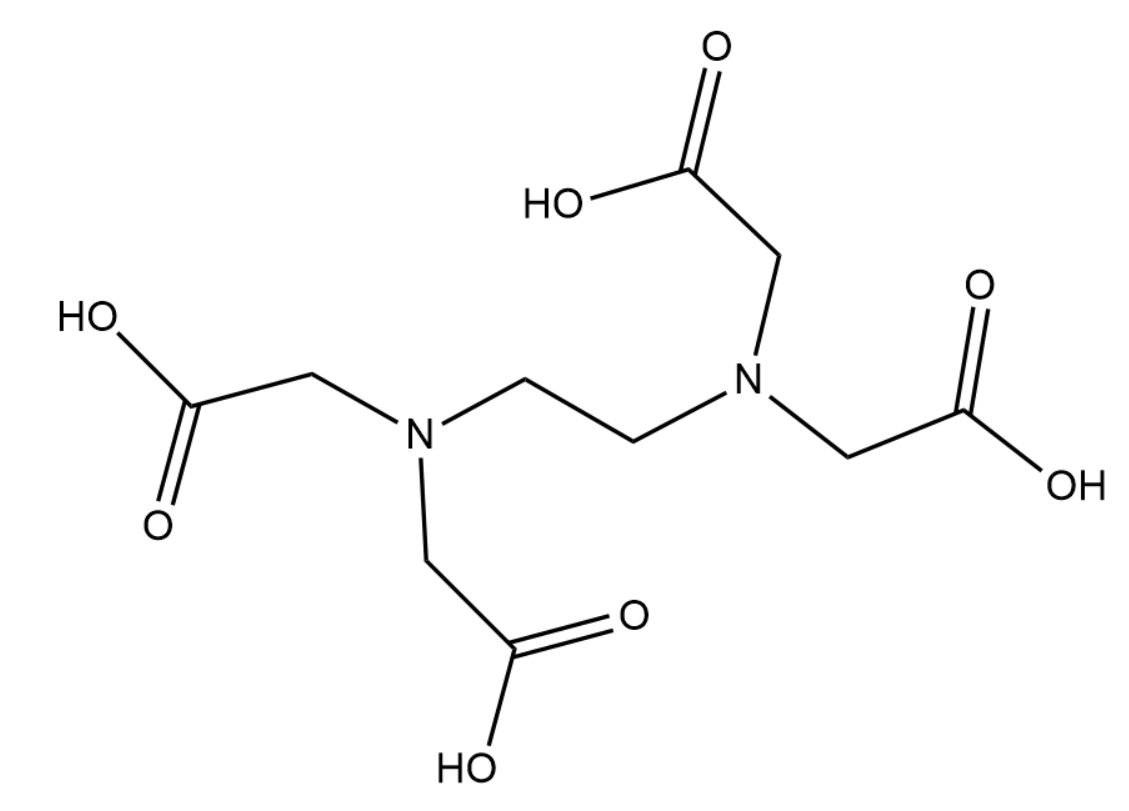
Is EDTA an Acid or Base?
Answer
405k+ views
Hint: EDTA stands for ethylenediaminetetraacetic acid. It is widely used in complexometric titrations and is a well-known metal-chelating agent, extensively used for the treatment of heavy metal poisoning. EDTA has four groups of carboxyl and two groups of amines.
The structure of EDTA is given below-

Complete answer:
From the name itself it is clear that EDTA is a weak acid. It behaves as an amino polyprotic acid. Due to the presence of the four carbonyl groups it can lose that hydrogen thus gaining a negatively charged \[CO{O^ - }\] group in each of the four acid groups. Thus EDTA is mildly acidic in nature.
EDTA can lose all 4 of its hydrogen and form\[EDT{A^{4 - }}\]. This along with the lone pairs on each nitrogen can form a total of 6 bonds with the metal ion. This is the reason why EDTA is called a hexadentate ligand. The metal-EDTA complex usually has an octahedral geometry.
Note:
Complexometric titration is a form of volumetric analysis that is used mainly to determine metal ions by use of complex-forming reactions. When EDTA is used alongside Eriochrome Black T (a blue indicator) the colour of the solution changes from wine red to blue indicating the presence of metal ions such as\[C{a^{2 + }},M{g^{2 + }}\]. EDTA has a claw-like structure that we use to stick and grab other molecules and thus forms coordination complexes with them.
The structure of EDTA is given below-

Complete answer:
From the name itself it is clear that EDTA is a weak acid. It behaves as an amino polyprotic acid. Due to the presence of the four carbonyl groups it can lose that hydrogen thus gaining a negatively charged \[CO{O^ - }\] group in each of the four acid groups. Thus EDTA is mildly acidic in nature.
EDTA can lose all 4 of its hydrogen and form\[EDT{A^{4 - }}\]. This along with the lone pairs on each nitrogen can form a total of 6 bonds with the metal ion. This is the reason why EDTA is called a hexadentate ligand. The metal-EDTA complex usually has an octahedral geometry.
Note:
Complexometric titration is a form of volumetric analysis that is used mainly to determine metal ions by use of complex-forming reactions. When EDTA is used alongside Eriochrome Black T (a blue indicator) the colour of the solution changes from wine red to blue indicating the presence of metal ions such as\[C{a^{2 + }},M{g^{2 + }}\]. EDTA has a claw-like structure that we use to stick and grab other molecules and thus forms coordination complexes with them.
Recently Updated Pages
Master Class 12 Social Science: Engaging Questions & Answers for Success

Class 12 Question and Answer - Your Ultimate Solutions Guide

Class 10 Question and Answer - Your Ultimate Solutions Guide

Master Class 10 Science: Engaging Questions & Answers for Success

Master Class 10 Maths: Engaging Questions & Answers for Success

Master Class 9 General Knowledge: Engaging Questions & Answers for Success

Trending doubts
Is Cellular respiration an Oxidation or Reduction class 11 chemistry CBSE

In electron dot structure the valence shell electrons class 11 chemistry CBSE

What is the Pitti Island famous for ABird Sanctuary class 11 social science CBSE

State the laws of reflection of light

One Metric ton is equal to kg A 10000 B 1000 C 100 class 11 physics CBSE

Difference Between Prokaryotic Cells and Eukaryotic Cells




